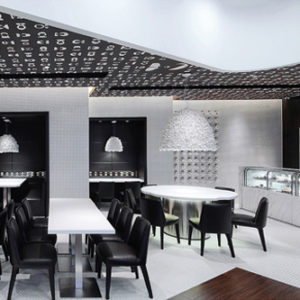


In 2013, Brazilian architect Henrique Steyer accepted for the first time to participate in an interior design exhibit. As usual for his work, he brought questionings about religion, sexuality and humor. The façade for the building was wrapped in a mix of angles, planes and shadows and filled with textures that represent the main religions and beliefs of the planet, to become the Temple of Worship to Design. The good design is always the fruit from the mind of a good designer, which in turn is the fruit of the “great Creator”.

The ecumenical façade embraces all beliefs in a playful way, presenting graphics created with faith symbols as the Christian Cross, the Star of David, the Om, the Yin Yang, and so on. Even the traditional Bonfim wristband from Bahia is represented in this setting, that also features a garden inspired in old churches. The scenic lighting highlights the entrance, with glass panes decorated to resemble cathedral mullioned windows. The intention is to show that here, everyone is accepted.

In the entrance hall, Steyer creates a temple in homage to the great Creator. His main creations, Adam and Eve, make a tongue-in-cheek appearance. Superimposed glass panes with provocative swimwear pieces create an illusion on the biblical ancestors’ oversize reproductions from the 1528 paintings by Cranach the Elder. Dark walls, lined with long black tufts serve as backdrop for the important sacred piece that welcomes visitors to the room, an antique 6’3″ angel carved in wood.

Behind him, a massive french mirror reflects his large wings. Alongside Adam and Eve, people-shaped bookshelves, created by Steyer, are lined with old Bibles. The access door is a reproduction of The Gates of Hell, by Auguste Rodin, adorned with a bronze serpent-shaped door handle. He who approaches quickly notices this is Heaven on Earth!



















